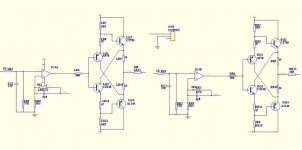Hi !
I just bought a board for this on Ebay.
Anybody have some experience or comments for this circuit?
Is it any good as a linestage in a preamp?
How does it sound?
Any take on component values before I start soldering?
Any input will be wellcome.
The pws is onboard standard LM317/337 setup
I just bought a board for this on Ebay.
Anybody have some experience or comments for this circuit?
Is it any good as a linestage in a preamp?
How does it sound?
Any take on component values before I start soldering?
Any input will be wellcome.
The pws is onboard standard LM317/337 setup
I use a similar circuit as a headphone amp - in mine the 3K9 resistors are active current sources. It sounds pretty good to me.
I scaled mine up a bit - the output devices are MJE15032/3, because I run it with enough bias current that it is class A for 32 ohm loads. Try your kit, it'll sound nice
I scaled mine up a bit - the output devices are MJE15032/3, because I run it with enough bias current that it is class A for 32 ohm loads. Try your kit, it'll sound nice
My plan is to use LME 49720
Good choice! I did the same. I have two of these boards from Jim's Audio. I built one but have not listened to it. I ran some square waves through it and they looked good. I matched the output transistors as well.
Tube Cad had a little discusion of using the Diamond buffer in a sort of unconventional way to use it to get 6db gain. To do this you let the center of the powersupply float and connect the output of the buffer directly to ground. Then you can use that center tap of your floating power supply as your output node.
Do you use A970/C2240 and A1145/C2705 as shown in the schematic?
Yeah! The output stage has no voltage gain, only current gain. The voltage is set around the op amp. You can make it what ever you want it to be.
Will 10 times amplification be suitable for a linestage ?
Yeah, that's plenty.
I would be very tempted to have a switchable gain.
+0dB, +6dB +12dB. (+0dB would be a direct wired bypass into a buffer circuit.)
and always use the lowest setting that gives adequate volume at your listening position.
But switchable (or any variable) gain leads to variable gain and phase margins. You need to find a way to ensure that similar margins are maintained at all gain settings, otherwise the results (sound output) are likely to be quite different.
+0dB, +6dB +12dB. (+0dB would be a direct wired bypass into a buffer circuit.)
and always use the lowest setting that gives adequate volume at your listening position.
But switchable (or any variable) gain leads to variable gain and phase margins. You need to find a way to ensure that similar margins are maintained at all gain settings, otherwise the results (sound output) are likely to be quite different.
I suspect that 100k/11k would have more noise than lower resistances. Try it to hear.
3k/330r would be a quite difficult load for the opamp to drive if there is also a low Zin and some capacitance to be fed. Could the opamp send full voltage signal through without performance deteriorating?
This might be quite difficult (resource expensive) to disprove.
I would be tempted to stick with the 10k/1k1 that is fairly typical of opamp stages.
3k/330r would be a quite difficult load for the opamp to drive if there is also a low Zin and some capacitance to be fed. Could the opamp send full voltage signal through without performance deteriorating?
This might be quite difficult (resource expensive) to disprove.
I would be tempted to stick with the 10k/1k1 that is fairly typical of opamp stages.
- Status
- This old topic is closed. If you want to reopen this topic, contact a moderator using the "Report Post" button.
- Home
- Amplifiers
- Solid State
- Diamond buffer
